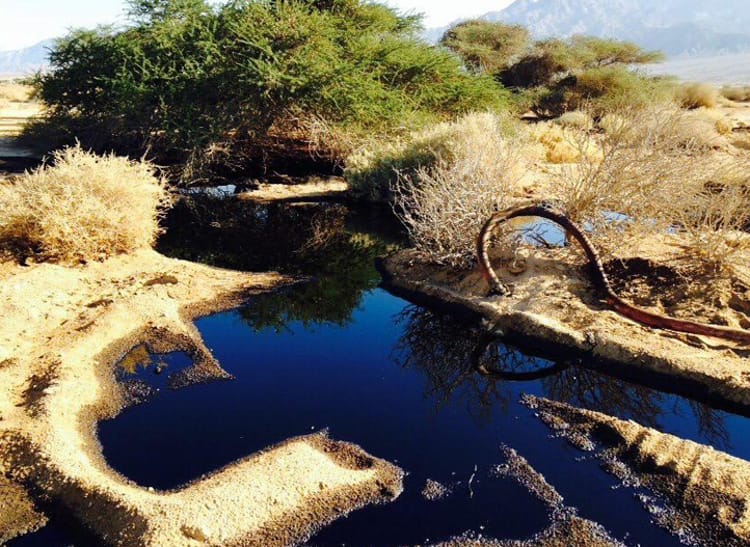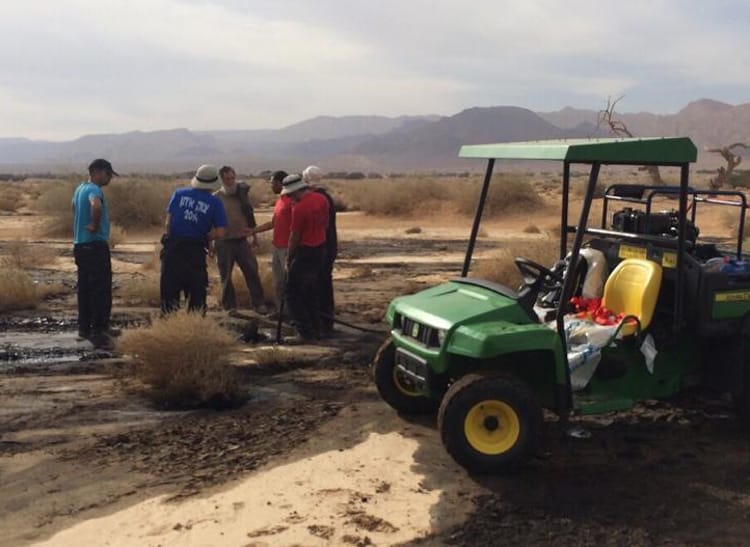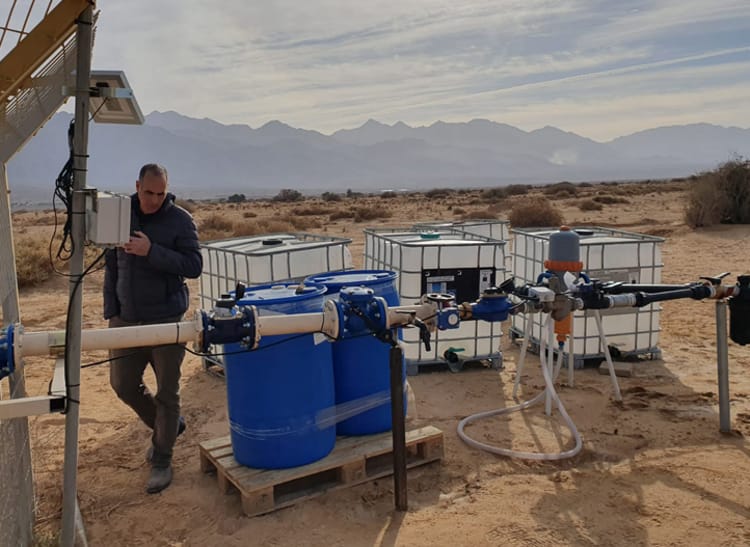A special bacteria and precision irrigation save a nature reserve
What’s the connection between precision irrigation technology and one of Israel’s most ambitious nature restoration projects? As a member of the Netafim family for over 15 years I witnessed time and again how identifying a need and dreaming up a solution has led us to develop innovative products and technologies that have made a huge impact on the agriculture industry. But sometimes reality tops anything you can imagine, and out-of the-box thinking takes on a whole new dimension. On December 4, 2014 Israel experienced one of the worst environmental disasters in the country’s history, five million cubic meters of crude oil polluted an area of 15 hectares in the Evrona nature reserve. Oil streams flowed for 7 km from the leak site and formed oil lakes which created a layer of crude oil beneath the surface preventing water from penetrating the soil endangering life in this beautiful and fragile natural ecosystem.

The race to save the Evrona reserve
The Evrona reserve is one of the most important ecosystems in the Arava desert region. It is home to a savanna of acacia trees, deer herds, plenty of waterfowl, salt ponds and more. A special report issued by an external consulting company concluded that the immediate efforts to clean up the spill would not lead to a solution or remedy the most significant ecological damage; the inability of the acacia trees to germinate in the oiled soils. The acacia is the only indigenous tree in the Arava; it provides food for a variety of animals and birds, upgrades the soil for the benefit of other plants, and it's deep roots contribute to the stability of the ground and prevent erosion. The disappearance of acacia trees could lead to the collapse of the entire ecosystem in the reserve.
The race to save the Evrona reserve began as five million liters of crude oil were seeping into its soil. The clock was ticking to find a solution to what was sure to be a very challenging mission. Israel Nature and Parks Authority (INPA) knew it was facing a real problem and in December 2014, issued a public statement calling on companies specializing in soil cleanup technologies to submit proposals for solutions to clean up the soil at the Evrona nature reserve. Companies that met the threshold conditions defined by INPA were invited to conduct a feasibility test on a strip of land allocated for this purpose.
One of these companies was LiquidGas, a relatively young and innovative company founded by a group of chief chemical engineers, who specialize in providing customized solutions for treating unique hazardous waste. LiquidGas developed a biological process that uses bacteria to break down long and heavy carbon chains originating from the pollution, turning them into short carbon chains that can decompose in nature. The company’s chemical engineers put together a smart mixture of soil-penetrating enhancers, microbiological boosters, and a special bacterium that breaks down the oil and is adapted to extreme surface conditions. This unique treatment was to lower the level of pollution, measured as TPH (Total Petroleum Hydrocarbons) to the point where the organisms in the reserve can handle the oil residue without further intervention. The company's engineers have created a matrix that indicated the optimal concentration and minimum irrigation needed to achieve a fast, high-quality and economical result.
Needed: A surgical approach to apply the bacterial cocktail
But how do you apply this bacterial cocktail to 15 hectares of nature reserve? Attempts to suck up the crude oil that accumulated in the crevices and canyons were only partially successful. The fact that the spillage occurred in a nature reserve required technological adjustments to provide a more surgical response as the Israel Nature and Parks Authority pressed many restrictions on the treatment for fear of adding more stress to the deteriorating ecosystem. How can you apply this bio-cocktail over a vast area while creating minimal impact on the wildlife in the reserve? How do you implement this massive delivery system quickly and then retrieve it after a few months with no heavy machinery? What kind of system can work uniformly and precisely over the challenging terrain?
That’s where we came into the picture with our experience and hydraulic technological capabilities. These would allow a precise and controlled flow of water and bacteria over a large and challenging topography and meet all the restrictions and requirements posed by INPA.
In 2019 Netafim joined forces with LiquidGas in a test pilot. More than 500 samples were taken throughout the pilot to perfect the model and to assure accurate and repeatable results. The half a hectare pilot plot showed a reduction of over 70% in pollution in just 3 months and LiquidGas, with ourselves, Netafim, as its subcontractor were assigned the entire restoration project.

Trials and tribulations on the road to ecological salvation
Moving from a half hectare test plot to 15 hectares posed huge logistical and operational challenges which required careful and detailed advanced planning. Here are some of the obstacles and special needs we had to meet:
- Hydraulic know-how: Distributing water and the bacteria uniformly over the entire contaminated surface which spread over a challenging topography. The oil flowed to the lowest areas and accumulated in narrow crevices which required the use of hydraulic technology.
- Water control: Using very small amounts of water - to avoid soil erosion and damage to the natural soil texture.
- Fold & Go system: Deploying a fully portable water dispersion system that could be retired and folded immediately at the end of the project quickly without using heavy mechanical tools.
- Remote project management: Executing the project remotely to reduce human activity that could disrupt the balance in the reserve and allows complete and precise control of the water dispersion.
- Precision soil treatment: Designing a system that can accurately inject the required materials for soil treatment.

Technology transfer at its best - precision irrigation to the rescue
The synergy between LiquidGas’ chemical knowledge and our hydraulic capabilities created a perfect match. Our experience in solving agricultural and hydraulic challenges came in handy and helped us to adapt our precision irrigation solutions to meet the many challenges posed by this project and maximize the application of LiquidGas’ special bacteria.
The solution we brought to this partnership was based on three key technologies borrowed from the world of precision agriculture:
-
A flexible light conduction pipe called FlexNet made out of a special polymer coated fabric. Its lightweight portability and durability made it a perfect choice for this delicate project which prohibited the use of heavy machinery and tools. It was easy to install, retrieve and relocate it. It was also so flat and light that, as far as the Nature & Parks Authority was concerned, it allowed the local snails (yes, snails!) to stay on course, un-interrupted.
-
Flow regulated micro-sprinklers which deliver perfect water-application uniformity even on steep slopes. Making sure every square meter of contaminated soil gets exactly the same amount of active bacteria cocktail.
-
Netafim’s remote control system that allows you to operate the irrigation system, monitor the flow of water and materials in the field, and receive real-time alerts.
Out-of-the box-thinking and determination (almost) always win
There were many other unexpected complications along the way; from rodents that were attracted to the sound of running water through the pipes, to frequency fogging of the remote control system from what we assumed to be the nearby new airport under construction. Luckily, we were resourceful and had a perfect partner on this challenging road. LiquidGas believed in our solution, understood the synergy between their bacterial cocktail and our delivery system and supported the operation throughout its trials and tribulations.
The soil remediation of the whole 15 hectares was finished by mid-2020, with a significant reduction in all parameters of the pollution. I am proud to be part of a company that is not afraid of challenges and sees it as an important mission to be involved in projects that use our knowhow and capabilities to save and protect our environment. Projects like this that require “out-of-the-box” thinking and creative execution lead us to the forefront of advanced irrigation technology and keep us on our toes.


Comments
We'd love to hear your thoughts! To enter a comment, type your name and email address.